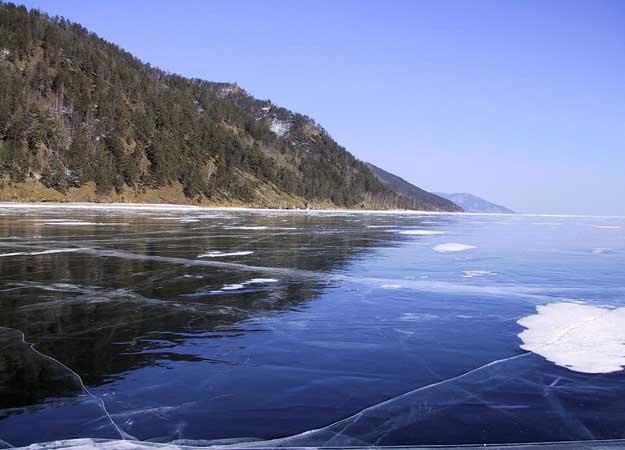Here are 10 of Discovery Earth's favorites from the World Heritage Sites list.
Giant's Causeway, Northern Ireland
Over 40,000 massive basalt columns rise out of the sea, the result of volcanic activity on the green isle some 50-60 million years ago.
These strange, stunning columns have spurred myths and research - from legends of giants using them to stride over the sea into Scotland to 300 years of serious geological studies and research.
Wadi Al-Hitan (Whale Valley), Egypt
This area south of Cairo tells one of Earth's most mindbending stories of evolution.
Bone and skeletons scattered throughout the area show the transformation of whales (suborder: Archaeceti) from land-based to ocean-swimming mammals.
Scientists have found fossils caught in the middle of the process: young whales losing their soon-to-be obsolete hind limbs.
Lake Baikal, Southeast Siberia
Formed 25 million years ago, Lake Baikal is the oldest, deepest lake in the world, reaching depths of 5,577 ft. - over a mile!
This icy oasis holds 20 percent of Earth's unfrozen freshwater supply, and sustains its own isolated wildlife species making Lake Baikal a prime site for researchers to study freshwater ecosystems and evolutionary science.
Located near the Russian-Mongolian border, you can see the lake's forested shores surrounded by snow-clad peaks of the Barguizin mountains in this photo.
Komodo National Park, Indonesia
How's this for a tourism hook: Komodo National Park, where Komodo dragons outnumber the locals.
It's true. The park is home to approx. 5,700 of these giant lizards and 4,000 people.
Located among the the volcanic islands of Indonesia's Wallacea region with its dry savannah and thorny green vegetation, the park is the only natural home for Varanus komodoensis in the world.
In addition to being named a World Heritage Site, the area has also been identified by both the World Wildlife Federation and Conservation International as a global conservation priority.
Grand Canyon, USA
Long hailed as one of the seven wonders of the natural world, the Grand Canyon remains one of Earth's greatest ongoing geological spectacles.
Approximately 65 million years ago what is now called the Colorado Plateau was uplifted 1.5 miles above sea-level. The Colorado River began carving its way down through the layers of rock 5-6 million years ago.
After millions of years of erosion, today the canyon is nearly one mile (1,500m) deep and nearly 18 miles (29km) across at its widest points.
The result: One of the most spectacular gorges in the world, with spectacular rock walls revealing 2 billion years of Earth's geologic history.
Ilulissat Icefjord, Denmark
Near the top of the world, lies the glacier Ilulissat Icefjord.
Situated on the west coast of Greenland near the town of Ilulissat and north of the Arctic Circle, this site offers scientists a magnificent natural laboratory for studying climate change and icecap glaciology.
It's significant because the area is actually a combination of several extraordinary natural phenomena. A huge ice-sheet moving at the rate of 62 ft. (19m) per day. Now, combine that with the dramatic sounds of a fast-moving glacial ice-stream careening into a fjord already covered by icebergs. It makes for some incredible icy fireworks not found anywhere else on Earth.
The Ilulissat Icefjord is one of the fastest and most active glaciers in the world, carving more ice per year than any glacier outside Antarctica.
Wulingyuan Scenic and Historic Interest Area, China
This strikingly beautiful site is best known for its unusual quartzite sandstone pillars and peaks - over 3,000 of them - but also the park abounds in endangered plants and animals.
Located in China's Hunan Province, the area has numerous ravines and gorges filled with streams, waterfalls, and pools, as well as caves and two large natural bridges.
In all, Wulingyuan spans over 64,200 acres.
Surtsey, Iceland
A series of volcanic eruptions from 1963-1967 formed this very young island off the southern coast of Iceland.
Because the island immediately received protected status, scientists have been able to study development of plant and animal life free of human influences in this small, isolated area.
Watching the process of a new world form, scientists observed that the first seeds arrived via ocean currents. Molds, bacteria, and fungi appeared next, followed by the first vascular plant in 1965.
This unspoiled natural laboratory is now home to 89 species of birds and 335 species of invertebrates.
Central Amazon Conservation Complex, Brazil
Made up of the Jau, Mamiraua, and Amana reserves, the complex is the largest protected tropical rainforest in the world. The area designated as a World Heritage protected site alone is larger than Switzerland.
Its forests, lakes, rivers, and islands are home to many continually changing terrestrial and freshwater ecosystems as well as many endangered species.
It's been given priority in the World Wildlife Fund as one of the most diverse and important bird areas in the world, as well a protected area for human cultures living in the reserves.
Great Barrier Reef, Australia
The Great Barrier Reef is a site for the record books.
Another spectacular place recognized as one of the seven wonders of the natural world, Australia's Great Barrier Reef also lays claim to being the only living, thriving ecosystem on Earth visible from space.
The marine park extends more than 1,800 miles (3,000 km) along the Queensland coast of northeast Australia, and it's home to the world's largest collection of corals - 400 distinct types!.
It's also home to 1,500 species of tropical fish, 4,000 types of mollusks, 200 types of birds and 20 types of reptiles, as well as many threatened species such as the dugong ("sea cow") and large green turtle.




















